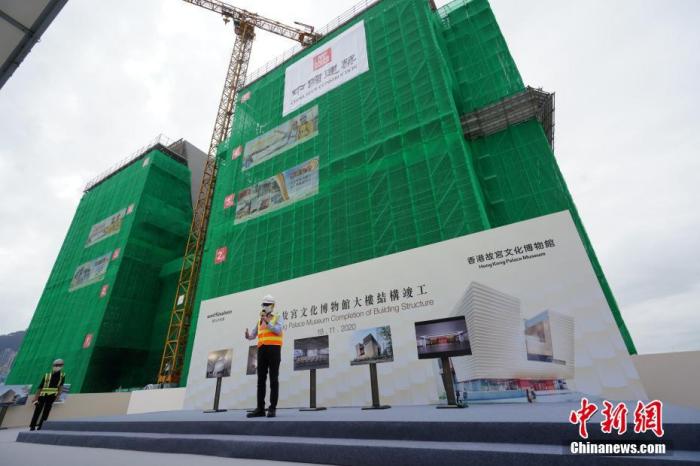China News Service, Hong Kong, November 18 (Reporter Liu Chenyao) The West Kowloon Cultural District Authority of Hong Kong announced on the 18th that the structure of the Hong Kong Palace Museum Building was completed, marking another milestone for this world-class museum and important cultural institution in Hong Kong. .
The picture shows Dr. Wu Zhihua, director of the Hong Kong Palace Museum, introducing the museum.
Photo by China News Agency reporter Zhang Wei
The Chief Executive of Hong Kong Special Administrative Region Carrie Lam visited the Hong Kong Palace Museum on the 18th to understand the progress of the project.
She said that the project was conceived when she visited the Forbidden City in the fall of 2015. At the end of the same year, it received the principled support of the Ministry of Culture, the National Cultural Heritage Administration and the Palace Museum, and carried out a project to seek funding from the Hong Kong Jockey Club Charity Trust Fund. Negotiations; officially announced in Beijing in December 2016; in June 2017, President Xi Jinping witnessed the signing of a cooperation agreement between the West Kowloon Cultural District Authority and the Palace Museum in the Hong Kong Palace Museum during his inspection in Hong Kong.
"In May 2018, I stood at my current position and presided over the groundbreaking ceremony of the new museum." As the conceiver and promoter of this large-scale cultural project, Carrie Lam said that the project has gradually become a reality from dreams and even fantasy. Feeling extremely excited.
"The Hong Kong Palace Museum has a broad vision and mission. It is committed to promoting the research and appreciation of Chinese art and culture, and promoting the dialogue between world civilizations and cultures. The museum is backed by the motherland, rooted in Hong Kong, and looking at the world. It cooperates with the Beijing Palace Museum and is committed to A new platform for international development and promotion of Chinese culture.” Carrie Lam hopes that the construction of this world-class museum of Chinese culture and art will establish a new landmark for Hong Kong that will attract international attention.
The museum is expected to open in the middle of 2022.
Chen Zhisi, Chairman of the Board of Directors of the Hong Kong Palace Museum, revealed that the discussion with the Beijing Palace Museum on the list of exhibits has been completed. The curatorial team has selected about 800 cultural relics for display in the opening exhibition, which will be loaned by the Palace Museum to other cultures. The institution has the largest number of cultural relics, and many cultural relics were unveiled overseas for the first time, and some cultural relics have never been exhibited.
The museum was built with a donation of HK$3.5 billion from the Hong Kong Jockey Club Charities Trust.
Chen Nanlu, Chairman of the Hong Kong Jockey Club, said that the Jockey Club is very honored to be able to donate to the construction of the Hong Kong Palace Museum and to implement the Jockey Club's mission of "committed to building a better society".
After the completion of the museum, it will definitely become a new landmark, allowing people from Hong Kong and even from all over the world to enjoy the treasures of Chinese culture here.
As the chief architect of the Hong Kong Palace Museum, Xu Liyan Architects Co., Ltd. hosted Yan Xunqi when meeting with the media that day. The design of the Hong Kong Palace Museum was inspired by the three elements of traditional architecture, art and Hong Kong's urban landscape.
The design of the three atrium spaces of the museum is based on the horizontally progressive spatial layout of the central axis of the Forbidden City. The space of the museum atrium progressively progresses vertically, connecting different floors into one.
It is understood that the seven-story museum will have five floors for exhibitions.
In terms of exhibits, Wu Zhihua, the director of the Hong Kong Palace Museum, told the media that the museum will have nine exhibition halls to fully introduce the culture of the Palace, including the architecture of the Forbidden City and the art collection of the Palace Museum, such as paintings, calligraphy, ceramics, and utensils.
(Finish)

